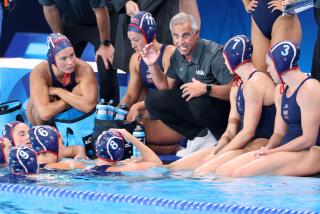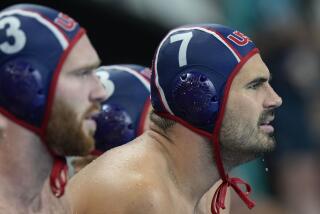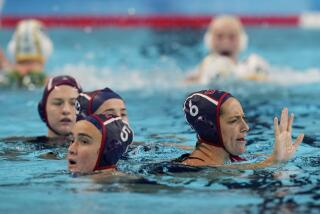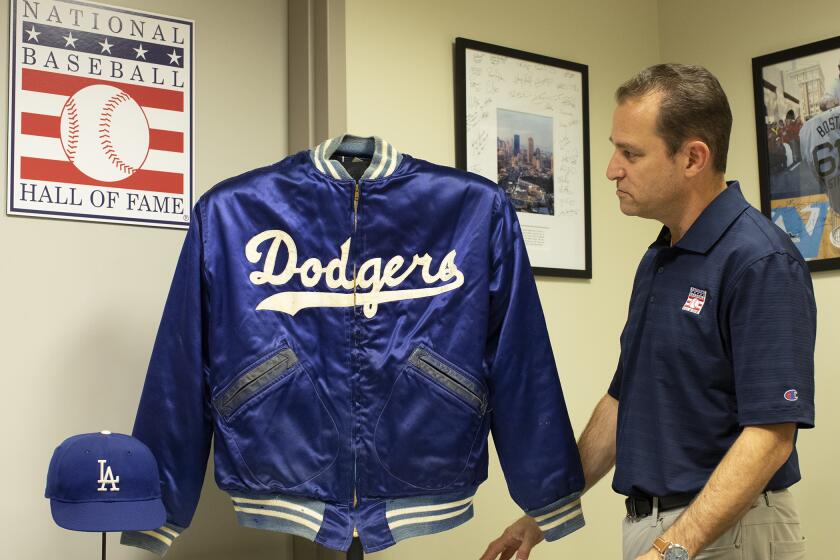Thundering Hooves, Flying Mallets, Flowing Bubbly
- Share via
CARPINTERIA — You go one-step, two-step, cha-cha-cha, being sure not to spill from your plastic flute of champagne. It’s halftime on the polo field and, with dozens of other spectators, you’re engaging in the ceremonial “stomping of the divots,” gingerly tamping down chunks of turf torn up by thoroughbred hooves.
The bubbly is provided gratis by the management of the Santa Barbara Polo & Racquet Club. The field’s hybrid Bermuda grass, bred specifically for polo, is barely pocked. Vaguely Latin music issues from the loudspeakers. Women in sundresses and floppy straw hats mingle with Stetson-topped cowboys. Laughter wafts over the huge, sun-splashed field, and you suddenly realize that, for sheer fun, the stomping of the divots beats the seventh-inning stretch by a gentrified mile.
“This is my favorite part of the day,” says sitcom writer Judith Williams as she scans the ground for divots. “It’s just so much fun, and such a beautiful place. And you see some really exciting riding. What could be better than this?”
A ticket to the Sunday afternoon polo matches here costs $10--the price of a nosebleed seat at Dodger Stadium. A swath of green nine times the size of a football field stretches before you, but at points, you’re just yards from a tangle of thundering hooves and flying mallets, close enough to see the horses sweat and hear the players explode in grunts of frustration.
If baseball forces you to sit through long stretches of meditative inaction, polo is nothing but movement, with the ponies flying down the field as fast as 35 mph and pirouetting on a dime to allow the perfect shot.
The game is relatively easy to follow despite sometimes-conflicting rules from the United States, Great Britain and Argentina, the world’s premier polo nation.
Two teams, each composed of four horses and riders, compete to shoot the ball through goal posts at either end of the field. But it takes a certain zeal to appreciate polo’s finer points, just as playing it requires stamina, precision and a taste for risk.
“To call it exhilarating is an understatement,” says Dr. Madison Richardson, a Los Angeles head and neck surgeon wearing a necktie depicting polo players going full throttle. “You can feel it from the top of your head to the tips of your toes. Every nerve is at peak sensitivity.”
It is not a sport without physical risks.
“So far this year, we’ve had three broken wrists,” says Tom Narozonick, the club’s general manager. “Last year, it was groin pulls.”
You don’t have to be rich to take up the pastime participants call the sport of kings, but it helps.
If you’re a serious player, you’ll pay $3,000 to $10,000 each for a string of seven or eight ponies; it takes at least six to get through one game, and some members own dozens. Once you’ve purchased them, you’ll still be looking at fees for club membership, boarding, grooming, transportation, feed, veterinary services--an annual cost of $40,000 to $60,000, according to polo experts.
It’s no coincidence that polo players have an average net worth of $966,000, according to the U.S. Polo Assn. Nor is it surprising that a hoary polo joke still coaxes out rueful chuckles around the Santa Barbara clubhouse:
Q. How do you make a small fortune in polo?
A. Start with a large one.
Even so, the sport’s aficionados bristle at its elitist image.
“It’s no more expensive than belonging to an expensive golf club,” says Glen Holden, a former U.S. ambassador to Jamaica and one of the club’s trustees.
At 73, Holden still plays--along with his son, son-in-law and grandson. A tall man with thick white hair, Holden keeps an eye on the field as he chats with a visitor on the clubhouse veranda, interrupting himself once to exclaim: “My God! What a magnificent play!”
President of the Federation of International Polo, Holden is lobbying to have polo restored to the Olympics, where it was last played in 1936.
“There are some purists who argue that the Olympics should test the best human athletes, not the best horses,” he says.
However, a plan to have ponies drawn from a pool rather than have riders on their favorite mounts may stem that concern, he says. If Beijing is chosen for the 2008 games, Holden says he could be off to China this fall, hoping to persuade officials there to construct polo fields.
Originating in ancient Asia, polo was introduced to the United States 125 years ago by James Gordon Bennett, publisher of the New York Herald newspaper. Today, some 3,500 players are registered with the U.S. Polo Assn., but the sport’s growth in the last five years has been slow, according to David Cummings, the association’s director.
“We’ve been gaining 600 new members a year, but losing 550,” he says. “When they leave, it’s usually for financial reasons.”
Market reverses weren’t a visible concern in the stands last Sunday. A few hundred spectators--many of them friends and relatives of the players--took in the sun, gazing off from time to time at the lush foothills beyond the field. At points, they cheered lustily for their teams, yelling “Go, Tuscany Oaks!” with the gusto of Laker fans.
As they watched, New Zealand-born announcer Nick Jones gave the play-by-play, occasionally lapsing into the King’s English. “The score is two-nil. . . . It’s Arellano cutting loose, it’s Arellano, it’s Arellano racing down the field, it’s Arellano at the goal--and oh! it isn’t to be. . . .”
This summer, the Pacific Coast Open will draw some of the world’s top professionals to the club, but members are unlikely to forget their own polo responsibilities in the excitement.
“You can’t put your horses in the corner like a bag of golf clubs and wait until you get inspired,” says Richardson, the Los Angeles physician, who used to practice his shots at night from a wooden pony installed in his Hancock Park backyard.
“You deal with it all day. When you’re not out there participating, you’re on the phone with your groom. It’s an all-consuming thing.”
More to Read
Go beyond the scoreboard
Get the latest on L.A.'s teams in the daily Sports Report newsletter.
You may occasionally receive promotional content from the Los Angeles Times.











